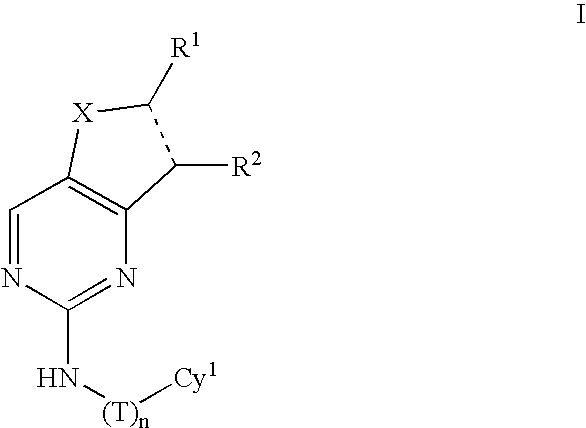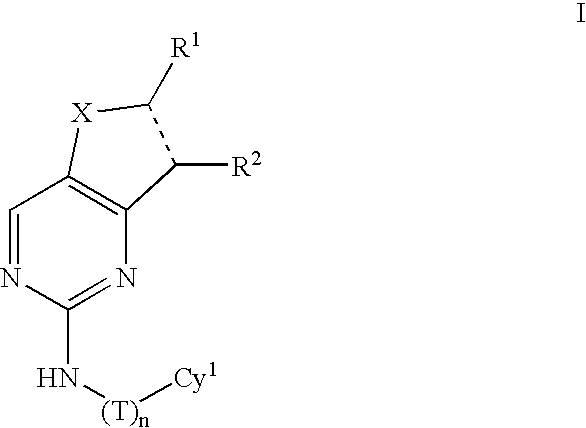Compositions useful as inhibitors of protein kinases
a technology of protein kinase and compound, which is applied in the direction of extracellular fluid disorder, metabolic disorder, immune disorders, etc., can solve the problems of abnormally high blood glucose levels, abnormal cell proliferation and other abnormalities, and failure of glycogen synthesis and glucose uptake, so as to prevent thrombin-induced platelet aggregation, prevent cell death and hyperplasia, and treat or prevent reperfusion/ischemia
- Summary
- Abstract
- Description
- Claims
- Application Information
AI Technical Summary
Benefits of technology
Problems solved by technology
Method used
Image
Examples
example 14
[0309]
2-Methanesulfonyl-thieno[2,3-h]quinazoline-8-carboxylic acid
[0310] 2-Methanesulfonyl-thieno[2,3-h]quinazoline-8-carboxylic acid tert-butyl ester (4.20 g, 11.52 mmol) was placed in a 500 mL Florentine and cooled in an ice-bath. Pre-mixed TFA:DCM:water (1:1:0.025, 4.5 mL) was added in one portion and the resultant solution was stirred at 0° C. for 0.75 hours and a further 0.75 hours at room temperature. The reaction mixture was concentrated under reduced pressure and azeotroped with portions of DCM (5×50 mL) and Et2O (5×50 mL). The solid obtained was triturated with Et2O, filtered and washed with Et2O (3×5mL) to give a light yellow powder (3.51 g, 99% yield). δH (d6 DMSO) 3.6-3.7(3H, s), 8.3(1H, d), 8.6(1H, d), 8.8(1H, s), 9.9-10.0(1H, s), 13.8-14.0(1H, br s)
example 15
[0311]
4-(2-Methanesulfonyl-thieno[2,3-h]quinazoline-8-carbonyl)-piperazine-1-carboxylic acid benzyl ester
[0312] 2-Methanesulfonyl-thieno[2,3-h]quinazoline-8-carboxylic acid (3.51 g, 11.38 mmol), 1-hydroxyazatriazole (1.70 g, 12.52 mmol), 1-benzylpiperazine carboxylate (2.76 g, 12.52 mmol) and diisopropylethylamine (1.62 g, 12.52 mmol) were dissolved in dry DMF (35 mL) and cooled in an ice-bath. EDC (2.40 g, 12.52 mmol) was added in one portion and the resulting suspension was stirred at 0° C. for 20 minutes and for a further 16 hours at room temperature. The reaction was concentrated under reduced pressure and partitioned between hot DCM and brine. The aqueous layer was extracted with DCM (3×50 mL) and the combined organics were washed sequentially with dilute HCl (1×50 mL), saturated Na2CO3 (1×50 mL) and brine (1×50 mL), dried over Na2SO4, filtered and concentrated under reduced pressure. The yellow wax obtained was subjected to column chromatography (50% EtOAc in DCM, loaded in D...
example 16
[0313]
4-[2-((R)-1-Phenyl-ethylamino)-thieno[2,3-h]quinazoline-8-carbonyl]-piperazine-1-carboxylic acid benzyl ester
[0314] 4-(2-Methanesulfonyl-thieno[2,3-h]quinazoline-8-carbonyl)-piperazine-1-carboxylic acid benzyl ester (0.2 g, 0.39 mmol), TFA (4.5 mg, 0.04 mmol) and (R)-(α-methyl)benzylamine (0.47 g, 3.92 mmol) was suspended / dissolved in dry dioxane (2 mL) and stirred at 120° C. for 16 hours. The reaction mixture was concentrated under reduced pressure and partitioned between DCM and dilute HCl. The organic layer was washed with saturated Na2CO3 (1×10 mL) and brine (1×10 mL), dried over Na2SO4, filtered and concentrated under reduced pressure. The brown gum obtained was redissolved in DCM, silica (˜5 mL) was added and the suspension was concentrated under reduced pressure. The solid obtained was subjected to column chromatography (25% EtOAc in DCM, ˜75 mL silica) to give a light yellow gum (198.4 mg, 92% yield). MS (ES+) 552, (ES−) 551. δH (CDCl3) 1.7 (3H, d), 3.6-3.7 (4H, br m)...
PUM
| Property | Measurement | Unit |
|---|---|---|
| temperature | aaaaa | aaaaa |
| temperature | aaaaa | aaaaa |
| mol % | aaaaa | aaaaa |
Abstract
Description
Claims
Application Information
 Login to View More
Login to View More - R&D
- Intellectual Property
- Life Sciences
- Materials
- Tech Scout
- Unparalleled Data Quality
- Higher Quality Content
- 60% Fewer Hallucinations
Browse by: Latest US Patents, China's latest patents, Technical Efficacy Thesaurus, Application Domain, Technology Topic, Popular Technical Reports.
© 2025 PatSnap. All rights reserved.Legal|Privacy policy|Modern Slavery Act Transparency Statement|Sitemap|About US| Contact US: help@patsnap.com



